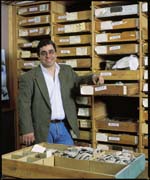 |
 |
| current issue |  |
past issues |  |
send a letter/news |  |
address update |  |
advertise |  |
about us |  |
alumni home |
Features
Bill Saturno and the Temple of (not quite) DoomA "day-trip" through the Guatemalan jungle leads to an amazing discovery.
by Anne Downey '95G
 Doug Prince / UNH Photographic Services
Doug Prince / UNH Photographic Services
|
The story of archaeologist William Saturno's latest discovery has all of the elements of an Indiana Jones movie: danger and hardship, looters, poisonous fruit, a lost temple and a work of art that has been called one of the most important finds in Mayan archaeology in recent decades.
Saturno, a research assistant professor at UNH, is also a research associate at Harvard's Peabody Museum, where he works for the Corpus of Mayan Hieroglyphic Inscriptions Project. In March 2001, he was sent to verify the existence of Mayan stelae, or carved monuments, at some ruins that had been discovered in Guatemala near the Mexican border. He hired a tour company that specializes in ecotourism to help with his arrangements, but the planned trip fell through when his guides decided that they didn't have enough time to travel to that site. Bernie Mittelstaedt, the director of the tour company, suggested an alternative. "He told me that he had information about stelae near San Bartolo, a site farther south, and that it would be an easy day-trip," Saturno recalls. The trip to the site turned out to be neither short nor easy. It took Saturno, Mittelstaedt and four other guides twelve hours to get as close as they could by vehicle. Then they struck into the jungle on foot, thinking that they would return to the vehicles in five hours at most. The temperature was in the 90s, and Saturno was carrying 50 pounds of camera equipment. The jungle was much denser than they expected, and they needed to use machetes to chop through fallen trees that loggers had left behind.
After more than eight hours of hard slogging, they found the site, but they had run out of food and water. Guatemala lies on a limestone shelf, so there is essentially no surface water, and there are no rivers. The men tried to extract water from vines by filtering resin through their shirts, but it was the end of the dry season, and they were able to get only about half a gallon. "At one point, I was resting in my portable hammock, remembering that I heard somewhere that if you are really dehydrated, you can drink your own urine," Saturno says. "And then it occurred to me that I hadn't urinated for at least 24 hours. You know it's a really bad day when you regret the fact that you have no urine to drink."
While his guides searched for caves or clay pools that might have collected rainwater, Saturno explored the ruins, looking for the rumored stelae. He found an area that once had been a plaza, with a cluster of three mounds facing a vegetation-covered pyramid, about 80 feet high. Preclassical Maya, who lived from 2,000 B.C. to approximately A.D. 200, built their temples on top of such structures. Saturno could see that looters had recently visited the site. They had dug a trench to get to the base of the pyramid and a tunnel into it, probably hoping to find pottery that they could sell on the black market. But he saw no sign of any stelae.
Saturno's trip was turning from a disaster into a nightmare, fast. Overheated, exhausted and severely dehydrated, he crawled into the looters' tunnel to get out of the sun and cool down. Just inside the entrance to the tunnel was an opening into a small room.
Page: 1 2 3 Next >Easy to print version
blog comments powered by Disqus

